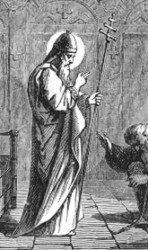
Pope Saint Zephyrinus
|

Pope Saint Zephyrinus![]() August 26th
August 26th ![]()
(Reigned 198-217).

Date of birth unknown; died 20 Dec., 217. After the death of Pope Victor in 198, Zephyrinus was elected his successor and consecrated. The pope is described by Hippolytus in the "Philosophymena" (IX, xi) as a simple man without education. This is evidently to be understood as meaning that Zephyrinus had not taken the higher studies and had devoted himself to the practical administration of the Church and not to theological learning. Immediately after his elevation to the Roman See, Zephyrinus called to Rome the confessor Callistus, who lived at Antium and who had received a monthly pension from Pope Victor, and intrusted him with the oversight of the coemeterium. It is evident that shortly before this the Roman Christian community had, under Victor, become the owner of a common place of burial on the Via Appia, and Zephyrinus now placed Callistus over this cemetery which was given the name of Callistus. Undoubtedly Callistus was also made a deacon of the Roman Church by Zephyrinus. He was the confidential counsellor of the pope, whom he succeeded. The positions of the Christians, which had remained favourable in the first years of the government of Emperor Septimus Severus (193-211), grew constantly worse, and in 202 or 203 the edict of persecution appeared which forbade conversion to Christianity under the severest penalties. Nothing is known as to the execution of the edict in Rome itself nor of the martyrs of the Roman Church in this era.
More, however, is certain concerning the internal disputes in the Roman Church over the doctrine of the Trinity. The adherents of the heretical teacher Theodotus the Tanner had been excommunicated with their leader by Pope Victor. They formed an independent heretical community at Rome which was ruled by another Theodotus, the Money Changer, and Aselepodotus. These men persuaded a confessor of Rome named Natalis, who had acknowledged his faith without wavering before the heathen judge and had suffered torture, to permit himself to be made the bishop of the sect for a monthly payment of 170 denarii. Natalis, however, received many warnings in dreams. At first he paid no attention to these visions, but on one occasion he believed that he had been severely tortured by angels and now he began to ponder the matter. Early in the morning he put on a penitential garment, covered himself with ashes, and threw himself with tears at the feet of Zephyrinus. He confessed his wrong-doing and begged to be received again into the communion of the Church, which was finally granted him (Eusebius, "Hist. eccl.", V, xxxii). In the same era the adherents of Montanus also worked with great energy at Rome. The Montanist Proculus (or Proclus) published a work in defense of the new prophecies. A refutation of Proclus in the form of a dialogue was written by a learned and rigidly orthodox Roman Christian named Caius, wherein he refers to the grave of St. Peter on the Vatican Hill and of St. Paul on the Via Ostiensis. Caius rejects the Apocalypse of St. John, which he regards as a work of the heretic Cerinthus. In opposition to Caius, Hippolytus wrote his "Capita contra Caium" (cf. Eusebius, "Hist. eccl.", III, xxviii; VI, xx).
Hippolytus was the most important theologian among the Roman presbyters of this era. He was an avowed adherent of the doctrine of the Divine Logos. He taught that the Divine Logos became man in Christ, that the Logos differs in every thing from God, that he is the mediary between God and the world of creatures. This doctrine in the form in which it was set forth by Hippolytus and his school aroused many doubts, and another theological school appeared in opposition to it. This latter school was represented at Rome in this era by Cleomenes and particularly by Sabellius. These men were rigid opponents of the Theodotians, but were not willing to acknowledge the incarnation of the Logos, and emphasized above all the absolute unity (monarchia) of God. They explained the Incarnation of Christ in the sense that this was another manifestation (modus) of God in His union with human nature. Consequently they were called Modalists or Patripassians, as according to them it was not the Son of God but the Father Who had been crucified. The Christian common people held firmly, above all, to the Unity of God and at the same time to the true Godhead of Jesus Christ. Originally no distrust of this doctrine was felt among them. Pope Zephyrinus did not interpose authoritatively in the dispute between the two schools. The heresy of the Modalists was not at first clearly evident, and the doctrine of Hippolytus offered many difficulties as regards the tradition of the Church. Zephyrinus said simply that he acknowledged only one God, and this was the Lord Jesus Christ, but it was the Son, not the Father, Who had died. This was the doctrine of the tradition of the Church. Hippolytus urged that the pope should approve of a distinct dogma which represented the Person of Christ as actually different from that of the Father and condemned the opposing views of the Monarchians and Patripassians. However, Zephyrinus would not consent to this. The result was that Hippolytus grew constantly more irritated and angry against he pope and particularly against the deacon Callistus whom, as the councillor of the pope, he made responsible for the position of the latter. When after the death of Zephyrinus Callistus was elected Roman bishop, Hippolytus withdrew from the Church with his scholars, caused a schism, and made himself a rival bishop.
Zephyrinus was buried in a separate sepulchral chamber over the cemetery of Calistus on the Via Appia (cf. Wilpert, "Die papstgruber und die Suciliengruft in der Katakombe des hl. Kallistus", Freiburg, 1909, 91 sqq.). The "Liber Pontificalis" attributes two Decrees to Zephyrinus; one on the ordination of the clergy and the other on the Eucharistic Liturgy in the title churches of Rome. The author of the biography has ascribed these Decrees to the pope arbitrarily and without historical basis.
Liber Pontificalis, ed. DUCHESNE, I, 139; DUCHESNE, Histoire ancienne de Peglise, 292 sqq.; LANGEN, Geschichte der römischen Kirche, I (Bonn, 1881), 200 sqq.; BAGEMANN, Die romische Kirche und ihr Einfluss auf Dissiplin und Dogma in den ersten drei Jahrhunderten (Freiburg in Mr., 1864), 84 sqq.; cf. also the bibliography to HIPPOLYTUS.
The Catholic Encyclopedia, Volume XV
Nihil Obstat, October 1, 1912, Remy Lafort, S.T.D., Censor
Imprimatur. +John Cardinal Farley, Archbishop of New York
|
|